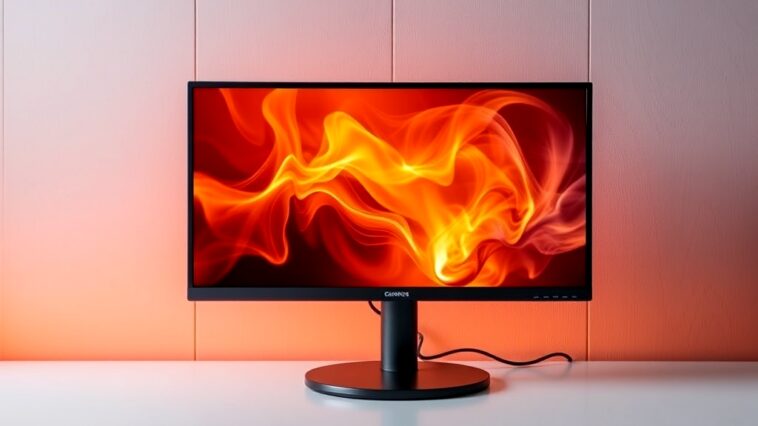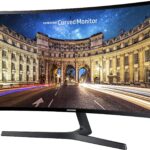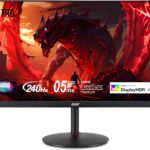So, you’re ready to level up your gaming experience, huh? You’ve got your high-performance rig, your pro-level peripherals, and now you’re on the hunt for the perfect gaming monitor. But with all the options out there, how do you choose the right gaming monitor? Don’t worry; you’re not alone. Let’s dive into this comprehensive guide that will help you make the best choice for your gaming needs.
Understanding Gaming Monitor Specifications for Optimal Performance
Alright, first things first—before you even think about brands or models, you need to understand the specs that matter. Ever wonder why some monitors look better than others? It’s all in the details.
- Resolution: This is the number of pixels that form the image on your screen. Higher resolutions mean clearer, sharper images. The common resolutions are:
- 1080p (Full HD): Good for most casual gamers.
- 1440p (Quad HD): A sweet spot for those who want more detail without breaking the bank.
- 4K (Ultra HD): If you’re looking for jaw-dropping visuals and have a powerful system to support it, this is the way to go. But remember, you need a hefty GPU to run games smoothly at this resolution.
- Refresh Rate: Measured in hertz (Hz), this indicates how many times per second the screen refreshes the image. Higher refresh rates provide smoother gameplay.
- 60Hz: Standard for casual gaming.
- 144Hz: Preferred by competitive gamers for smoother visuals.
- 240Hz: If you’re taking eSports seriously—this is your jam.
- Response Time: This is how quickly a pixel can change from one color to another, usually measured in milliseconds (ms). Lower response times minimize motion blur, which is crucial for fast-paced games. Look for monitors with a response time of 1-5ms for optimal performance.
- Panel Types: Different panel technologies can impact color accuracy, viewing angles, and response times. The main types are:
- IPS: Great colors and viewing angles but can be slower.
- TN: Fast response times but poorer color reproduction.
- VA: Good contrast and color but can be slow as well.
So, understanding these specifications is crucial for making an informed decision. You don’t want to grab a monitor just because it looks cool—well, unless you’re into that sort of thing.
Gaming Monitor Size and Resolution Guide for Gamers
Now that you’ve got the specs down, let’s talk about size. This might seem trivial, but trust me—size matters. You don’t want a monitor that feels too big or too small for your setup.
- 24 to 27 inches: This is generally considered the sweet spot for gaming. A 24-inch monitor at 1080p is great for a desk setup, while a 27-inch monitor might be better suited for 1440p or higher resolutions.
- 32 inches and above: If you’re playing from a distance—like, lounging on your couch—then larger monitors can provide an immersive experience. Just keep in mind that you might need to invest in a 4K monitor if you go this route.
Also, consider the desk space you have. You don’t want your monitor to dominate your entire setup, but you also want it to be big enough to immerse you in the game. It’s a fine balance, kinda like trying to find the right amount of toppings on a pizza—too much, and it’s a mess; too little, and it’s just sad.
Best Gaming Monitor Features for Different Game Genres
Different games require different features. Let’s break it down:
- For Fast-Paced Shooters: Look for a monitor with a high refresh rate (144Hz or higher) and low response time (1ms). You want every millisecond to count, right? The more responsive your monitor, the better your aim will be—well, at least, that’s the hope.
- For RPGs and Strategy Games: Color accuracy and a larger screen can enhance your gaming experience. Think about an IPS panel here for those breathtaking landscapes and intricate details. Plus, a higher resolution will make those magical realms pop!
- For Racing Games: A wide aspect ratio can help you see more of the track. Consider ultra-wide monitors (21:9 or 32:9) for a more immersive experience. Just imagine zooming around a track with the scenery blurring by—it’s like you’re in a Fast and Furious movie!
- For Casual Gaming: You don’t need the latest and greatest. A solid 1080p monitor with decent specs will do the trick. Just make sure it’s comfortable for your eyes, especially if you plan on gaming for hours on end.
Comparing Refresh Rates and Response Times in Gaming Monitors
Okay, here’s the deal—refresh rates and response times are often confused, but they’re not the same thing. Imagine running a race; the refresh rate is how often you can take a step, while the response time is how quickly you can change direction.
- Refresh Rate: As mentioned earlier, this is about how many times your monitor refreshes the image per second. A higher refresh rate means smoother gameplay. If you’re playing fast-paced games like Call of Duty or Overwatch, you’ll want a monitor that can keep up with your reflexes.
- Response Time: This is all about how fast a pixel can change color. If the response time is too slow, you’ll see ghosting effects, which can be distracting. For competitive gaming, aim for a monitor with a response time of 1ms. At the end of the day, you want to avoid looking like you’re playing in slow motion, right?
When comparing these two features, keep your gaming style in mind. If you’re a casual gamer, you might not notice much of a difference. But for those serious about competing—this is where it counts.
How to Select a Gaming Monitor for Competitive Gaming
Now, if you’re aiming for the top echelons of competitive gaming, your choice of monitor is vital. It’s not just about looking good; it’s about performance.
- Prioritize Refresh Rate and Response Time: Go for a monitor with at least a 144Hz refresh rate and a 1ms response time. Seriously, this is non-negotiable if you want to compete at a high level.
- G-Sync or FreeSync: These technologies help to eliminate screen tearing and stuttering. If you’re using an NVIDIA graphics card, look for G-Sync compatibility. AMD users should aim for FreeSync. It’s like having your cake and eating it too!
- Adjustable Stand: It’s not the most glamorous feature, but having an adjustable stand can help you maintain the perfect eye level, reducing neck strain during those marathon sessions.
- Multiple Input Options: You may want to connect your monitor to multiple devices—like a gaming console and a PC—so having various input options (HDMI, DisplayPort) is a plus.
- Good Warranty and Customer Support: You never know when you might need help. A good warranty can save your bacon if something goes wrong.
Affordable Gaming Monitor Options for Budget-Conscious Gamers
But what if you’re on a budget? Don’t fret! There are plenty of affordable gaming monitors that won’t break the bank. Here are a few options to consider:
- Acer R240HY: This 24-inch monitor offers 1080p resolution and an IPS panel for great color accuracy. It’s not the fastest, but if you’re just getting into gaming, it’s a great starting point.
- ASUS VG245H: This is a solid choice for console gamers. With a 75Hz refresh rate and 1ms response time, it’s perfect for fast-paced games without being too pricey.
- BenQ ZOWIE XL2411: A bit more geared towards competitive gaming, this monitor packs a 144Hz refresh rate and 1ms response time, all while being relatively affordable.
- LG 27UK650-W: If you want to dip your toes into 4K without spending a fortune, this monitor is a decent pick. It’s 27 inches, has great color accuracy, and won’t make your wallet cry.
Remember, just because you’re on a budget doesn’t mean you have to compromise too much on quality. There are options out there that can provide a great gaming experience without costing an arm and a leg.
Top Brands and Models of Gaming Monitors in 2025
Alright, now let’s talk brands. In 2025, several gaming monitor brands are dominating the market. Here are a few you should keep an eye on:
- ASUS: Known for their ROG (Republic of Gamers) line, ASUS monitors are often favored by pro gamers for their performance and features.
- Acer: Their Predator series offers high refresh rates and great color accuracy, making them a favorite among competitive gamers.
- Dell: The Alienware monitors are not only stylish but also packed with features that cater to gamers. Plus, they’re built to last.
- LG: Their ultra-wide monitors have gained traction for those who want an immersive experience in both gaming and productivity.
- Samsung: Known for their curved monitors, Samsung offers a unique viewing experience that many gamers find appealing.
When selecting a monitor, remember that the brand can affect your experience, but it’s the individual model’s specs that matter most.
Conclusion: Finding the Ideal Gaming Monitor
So, there you have it—a comprehensive guide to choosing the right gaming monitor. At the end of the day, it all boils down to your personal gaming style, budget, and preferences.
Do your research, consider the features that matter most to you, and don’t be afraid to ask for opinions from fellow gamers. You might even stumble upon some hidden gems!
And remember, gaming should be fun, not just about the specs. So whether you’re crushing your enemies in a battle royale or exploring vast RPG worlds, pick a monitor that enhances your experience. Happy gaming!
Other Related Articles
- Eizo Foris FS2331 Review
- How Much Power Does a 144Hz Monitor Use? A Deep Dive into Energy Consumption
- Should I Turn On HDR for Gaming? A Comprehensive Guide
- Is iPhone 16 Pro OLED the Best Display Yet?
- Understanding Panel Variance: What It Means for Your Monitor Purchase
- Can You Throw Computer Monitors in the Trash? The Ultimate Guide to Eco-Friendly Disposal
- Understanding VESA ClearMR: The Future of Motion Clarity in Displays
- 4K vs 1080p – Is UHD Worth The Upgrade?
- How To Choose The Right Gaming Monitor: A Comprehensive Guide
- IPS vs OLED Monitors for Color Accuracy: The Ultimate Showdown
- HDMI 2.1: The Future of Home Entertainment and Gaming
- How to Connect Heart Rate Monitor to PC?
- Curved vs Flat TV – Which Should You Choose? The Ultimate Showdown for 2025
- Can You Connect M-Audio Monitors to PC?
- Why Is My PC Showing the Same Display on Two Monitors?
- Why Are Computer Monitors More Expensive Than TVs?
- The Best Flicker-Free Monitors for Eye Care
- Monitors for Mac vs Windows PCs: The Ultimate Showdown
- 1920×1080 vs 2560×1440 – Which One Should I Choose?
- 99219444 Toshiba and Its Revolutionary Features for Tomorrow’s Tech Landscape
- OLED vs QD-OLED: The Showdown of Display Technologies
- What Is DisplayPort 2.1?
- What Is The Best Monitor Size For Gaming?
- 720p vs 1080p vs 1440p vs 4K vs 8K – Which Should I Choose?
- Is An HDR Gaming Monitor Worth It?
- Mini-LED vs MicroLED: What’s the Difference?
- Do Pawn Shops Take Computer Monitors?
- What LG Computer Monitor is as Good as the C3?
- Understanding Pixel Walk and Pixel Inversion
- Curved vs Flat Monitors for Work: Which One is Right for You?
- What Is The Soap Opera Effect?
- 4K vs 1440p Monitors for Video Editing: Which One Should You Choose?
- Do I Have to Attach a Hood to My BenQ Monitor?
- Can You Use Mac as a Monitor for PC?
- What Is G-SYNC And What Does It Do?
- Daz Studios Summoner G8 for the Visionary Artist
- Dell vs HP Monitors for Gaming
- Understanding IPS Technology: A Comprehensive Guide
- 27-Inch Monitors vs 32-Inch Monitors for Productivity
- Understanding Screen Resolution: Why It Matters for Your Displays
- How to Transport Computer Monitors?
- How to Dispose of Computer Monitors?
- What Is 4K Resolution And Is It Worth It?
- How to Pack Computer Monitor for Moving?
- What Is HDR For TVs And Is It Worth It?
- 1440p or 144Hz – Which Is Best For You?
- USB Type-C Explained – Everything You Need To Know
- Samsung’s Exciting Journey into Glasses-Free 3D Displays at Gamescom 2024
- I Have A Problem with My Samsung Odyssey G3 Monitor Setup
- Is A 144Hz Monitor Worth It? A Comprehensive Guide
- Understanding FALD Blooming and the Halo Effect: A Deep Dive
- What Does 144Hz Mean? Understanding Refresh Rates in Simple Terms
- Is an UltraWide Monitor the Right Choice for You?
- Active vs Passive 3D – What’s The Difference?
- Understanding Glare Control in Luminaires for Computer Users
- Why Does My Acer Monitor Keep Going Black?
- Understanding Motion Blur Reduction: A Gamer’s Guide
- How to Connect Studio Monitors to PC?
- Misleading Monitor Specifications You Should Look Out For
- QLED vs OLED – Which Is Best?
- Understanding VESA AdaptiveSync and MediaSync: The Future of Display Technology




